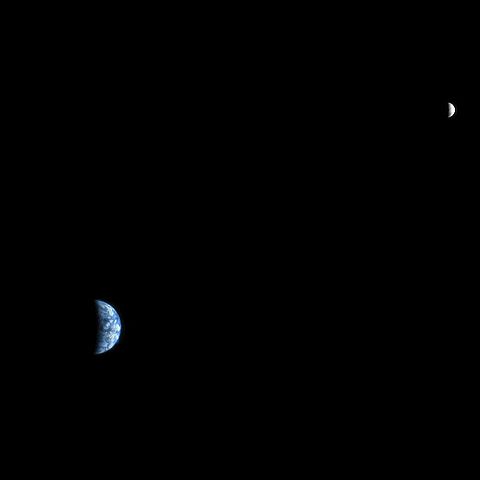
File:The Earth and the Moon photographed from Mars orbit.jpg

| |
This is a file from the Wikimedia Commons. Information from its description page there is shown below.
Commons is a freely licensed media file repository. You can help. |
Summary
| DescriptionThe Earth and the Moon photographed from Mars orbit.jpg |
English: Original caption:
The High Resolution Imaging Science Experiment (HiRISE) camera would make a great backyard telescope for viewing Mars, and we can also use it at Mars to view other planets. This is an image of Earth and the moon, acquired on October 3, 2007, by the HiRISE camera on NASA's Mars Reconnaissance Orbiter. At the time the image was taken, Earth was 142 million kilometers (88 million miles) from Mars, giving the HiRISE image a scale of 142 kilometers (88 miles) per pixel, an Earth diameter of about 90 pixels and a moon diameter of 24 pixels. The phase angle is 98 degrees, which means that less than half of the disk of the Earth and the disk of the moon have direct illumination. We could image Earth and moon at full disk illumination only when they are on the opposite side of the sun from Mars, but then the range would be much greater and the image would show less detail. On the day this image was taken, the Japanese Kaguya (Selene) spacecraft was en route from the Earth to the moon, and has since returned spectacular images and movies (see http://www.jaxa.jp/projects/sat/selene/index_e.html). On the Earth image we can make out the west coast outline of South America at lower right, although the clouds are the dominant features. These clouds are so bright, compared with the moon, that they are saturated in the HiRISE images. In fact the red-filter image was almost completely saturated, the Blue-Green image had significant saturation, and the brightest clouds were saturated in the infrared image. This colour image required a fair amount of processing to make a nice-looking release. The moon image is unsaturated but brightened relative to Earth for this composite. The lunar images are useful for calibration of the camera. Polski: Ziemia i Księżyc widziane z Marsa
Marsjańska orbitalna kamera ang. High Resolution Imaging Science Experiment (HiRISE), będąca wspaniałym teleskopem do oglądania powierzchni Marsa, może być także użyta do oglądania innych planet. Obraz Ziemi i Księżyca, został wykonany w dniu 3 października 2007 roku, przez kamerę HiRISE, znajdującą się na pokładzie należącego do NASA orbitera Mars Reconnaissance Orbiter. W czasie kiedy to zdjęcie zostało wykonane, Ziemia była oddalona 142.000.000 km od Marsa, dając obraz HiRISE o skali 142 km na piksel, co dla średnicy Ziemi oznaczoło około 90 pikseli i dla średnicy Księżyca 24 pikseli. Kąt fazowy wynosi 98 stopni, co oznacza, że mniej niż połowa tarczy Ziemi i dysku księżyca mają bezpośrednie oświetlenie słoneczne. Wykonanie zdjęcia Ziemi i Księżyca w pełnej iluminacji jest możliwe tylko wtedy, gdy są one na przeciwnej stronie Słońca niż Mars, ale wtedy odległość do nich byłaby znacznie większa, a obraz pokazywałby mniej szczegółów. W dniu, w którym zdjęcie to zostało zrobione, japoński statek kosmiczny Kaguya (Selene) był w drodze z Ziemi na Księżyc, a później przesłał spektakularne zdjęcia i filmy (patrz http://www.jaxa.jp/projects/sat/selene/index_e.html). Chociaż dominującym elementem są chmury, w prawym dolnym rogu obrazu Ziemi, możemy rozpoznać kontur zachodniego wybrzeża Ameryki Południowej. Chmury są tak jasne, w porównaniu z Księżycem, ponieważ są nasycone w obrazach HiRISE. W rzeczywistości czerwony filtr został prawie całkowicie nasycony, niebiesko-zielony był nasycony w stopniu znaczącym, a najjaśniejsze chmury były nasycone w podczerwieni. Ten kolorowy obraz wymagał rzetelnego przetworzenia, aby uzyskać oczekiwany efekt. Obraz Księżyca jest nienasycony, ale rozjaśniony względem Ziemi. Zdjęcia Księżyca są przydatne do kalibracji kamery. Image Credit: NASA/JPL-Caltech/University of Arizona |
| Date | |
| Source | http://www.nasa.gov/mission_pages/MRO/multimedia/mro20080303earth.html |
| Author | NASA/JPL-Caltech/University of Arizona |
Licensing
| Public domainPublic domainfalsefalse |
 |
This file is in the public domain because it was solely created by NASA. NASA copyright policy states that "NASA material is not protected by copyright unless noted". (See Template:PD-USGov, NASA copyright policy page or JPL Image Use Policy.) |
 |
 |
Warnings:
|
 |
This is one of the images forming part of the Valued image set: Earth from space on Wikimedia Commons. The image set has been assessed under the valued image set criteria and is considered the most valued set on Commons within the scope: You can see its nomination at Commons:Valued image candidates/Earth from space. |
File usage
Learn more
Wikipedia for Schools is designed to make learning fun and easy. By supporting vulnerable children right through to adulthood, SOS Children's Villages makes a lasting difference to the lives of thousands of people. Education is a key part of our work, and our schools provide high-quality teaching to the children in our care. Will you help another child today?
